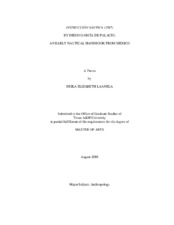| dc.description.abstract | In 1587, an ambitious colonial bureaucrat in Mexico City published a handbook
titled Instrucción náutica. Although navigational books were common throughout the
16th century, the Instrucción náutica was the first printed volume that included an
extensive discussion of ship construction and design, and its publication was thus a
significant event in the history of early modern nautical technology. While the work is
frequently cited in discussions of 16th-century Spanish ship construction and seafaring,
little in-depth analysis of the text has been undertaken to verify its accuracy. In order to
understand the significance of the book, a critical evaluation was undertaken of its
context and content and of the motivations and background of its author.
Analysis of documents written by, about, and to Diego García de Palacio reveals
that he held positions of academic, religious, and political power in New Spain, that his
motives for publishing the book were complex, and that he consulted a range of
disparate sources. Significantly, archival correspondence suggests that García de
Palacio was an observer and administrator of navigation and ship construction, rather
than an expert practitioner. Nonetheless, comparison of the technical content of the book with other sources
of information for 16th-century ships and seafaring, including contemporary treatises,
iconography, and archaeological materials confirms the overall accuracy of the text. The
navigational materials included in the Instrucción náutica reflect information adapted
from existing texts, providing a solid overview of the most common techniques of
navigation in use at the time. While useful, García de Palacio’s discussion of ship
design was clearly intended for a non-specialist audience. Perhaps the most original
technical contributions are his descriptions of the rigging of Spanish ships. The brief
discussion of naval strategy is historically significant due to its juxtaposition between the
last of the great naval battles fought primarily with boarding tactics, and the movement
toward increasing reliance on the broadside.
By comparing García de Palacio’s text to other sources of information, this study
has confirmed the reputation of the Instrucción náutica as one of the most
comprehensive and accurate written descriptions of 16th-century Spanish seafaring
practices. | en |


